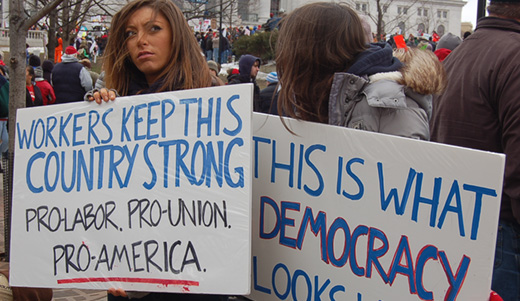
Anyone who thinks the upsurge by workers all across America is not of historic proportions hasn’t been paying attention.
Many in the labor movement believe that the thousands on the march in Wisconsin, Indiana, Ohio, Michigan, New Jersey, Florida, New York and elsewhere have ignited flames that, like scattered prairie fires, can potentially come together into one big burn for justice.
The demonstrators who are shouting “This is what democracy looks like” are showing, they say, what a workers’ uprising looks like.
“This wasn’t one union calling on members to turn out,” said AFL-CIO President Richard Trumka recently. “It wasn’t the AFL-CIO making the call. It wasn’t the Democratic Party, or the Obama organization. This was a bottom-up, grassroots movement, a true spontaneous outcry against our disastrous winner-take-all political culture.”
Although unions are often leading the demonstrations, the grassroots groups with which the union members are marching are changing unions themselves, perhaps forever.
It’s noteworthy that “Rebel Girl” Elizabeth Gurley Flynn (1890-1964) is soon to be inducted into the International Labor Hall of Fame in a ceremony at Teamsters headquarters in Washington. Flynn was active in the Industrial Workers of the World, an organizer for restaurant, garment and mine workers, and a founding member of the American Civil Liberties Union. Indicted under the notorious Smith Act, she served a two-year prison term because of her membership and leadership role in the Communist Party USA.
Only a short time ago such a commemoration by the mainstream labor movement would have been considered as politically unthinkable.
Another sign of the times: In Madison, Wis., the scene one night during the occupation of the Capitol was thus: Some 600 people were spending the night there in sleeping bags, lying on their coats or sleeping on the bare marble floors. The Capitol police were ordered to disperse them. The chief of the Capitol police told the crowd about his orders and then told them he and his officers were not going to follow those orders but instead would sleep in with the demonstrators.
A Wisconsin AFSCME organizer invited pro-labor filmmaker Michael Moore to speak at one of the big Madison rallies. Some state union leaders were reportedly nervous about Moore being too radical and urged that the organizer hold off on the invitation. He went ahead with the invitation anyway, and Moore received a tumultuous welcome from the tens of thousands who gathered to hear him. Almost immediately the AFL-CIO websites were quoting the Moore speech extensively.
In all the events the breadth of the crowds and their enthusiasm was more than evident as the huge non-union majority of the demonstrators – Black, Brown, white, male, female, gay and straight, young and old – marched together with the union members in a fight for collective bargaining rights and democracy. Ironworkers and construction workers marching and rallying in the hallways and rotunda of the Wisconsin Capitol had no problem with and cheered along with the students and “long hairs” who banged on drums after they spoke.
“Who would have predicted six weeks ago that every time you turned on your computer or radio or television, or picked up a newspaper, the news would be focused for weeks on end on a term that defies the brevity of the sound bite – collective bargaining?” asked Trumka asked in a speech at St. John’s University in New York March 18.
“We have wanted this debate for years. Now it’s here and guess what? The American people have said Yes to collective bargaining!” declared Trumka.
“Just why are firefighters, nurses, teachers, police officers, construction workers and other regular folks willing to march and rally for it, to pack Capitol buildings day and night for weeks on end?,” he asked. “It’s because of the two things you’ve gathered here to discuss: the basic legal rights of working people and the fundamental dignity of work.”
Union leaders see grabbing hold of the opportunities presented by the upsurge as critical to the very survival of the labor movement.
Fire Fighters union President Harold Schaitberger said last week that unions are fighting “a battle of proportions I haven’t seen in 40 years” against “the most coordinated, comprehensive anti-worker campaign in decades.”
AFL-CIO staffer Naomi Walker, who tracks state and local developments for the labor movement, said there are currently 500 distinct attacks on workers’ rights being mounted by right-wing politicians across the country. “That anti-union drive, state by state, is fueled by millions of dollars in right-wing money,” she said. She included on her list the Koch brothers – the wealthy far-right oil men from Kansas City, the Koch front group called Americans for Prosperity, the Chamber of Commerce, the American Legislative Exchange Council and the fund0raising operations of Karl Rove, chief political operative for former President George W. Bush.
To fight off this attack, the building of alliances is seen now by labor as more critical than ever. “We’re trying to change our language, not talking just about unions and our members, but talking about the threat to everyone’s rights,” Schaitberger said.
He compared the anti-union onslaught by the extreme right to President Ronald Reagan’s firing of 14,000 PATCO air traffic controllers in 1981 just as both Reagan and organized labor were strongly supporting Solidarnosc, the union organizing in Poland.
“While we were celebrating trade unionism in Poland, they [the controllers)] were fired and put in leg shackles and barred from ever getting jobs again in their profession,” said Schaitberger. “That was a defining moment and the labor movement blinked. This is our defining moment and we cannot afford to blink again.”
Photo: Madison, Wis., March 12, 2011. People’s World

MOST POPULAR TODAY


Zionist organizations leading campaign to stop ceasefire resolutions in D.C. area

Communist Karol Cariola elected president of Chile’s legislature

Afghanistan’s socialist years: The promising future killed off by U.S. imperialism

High Court essentially bans demonstrations, freedom of assembly in Deep South






Comments